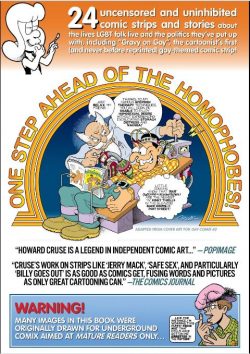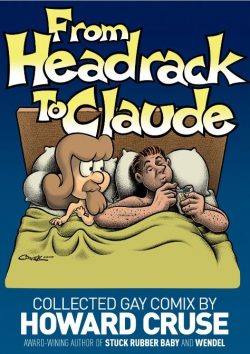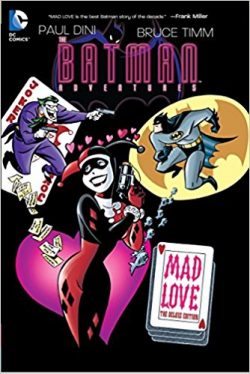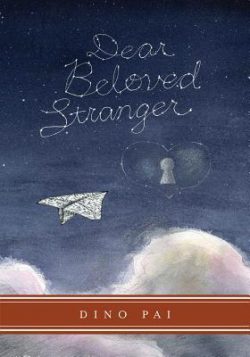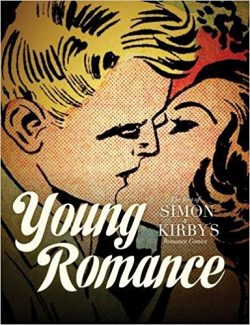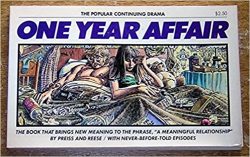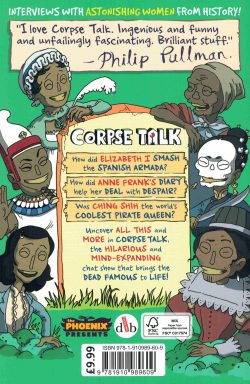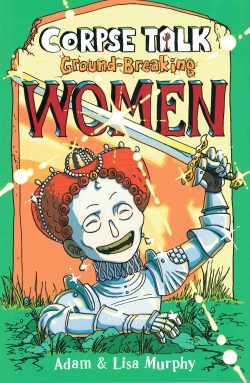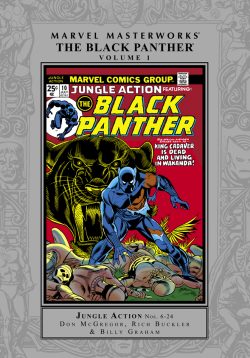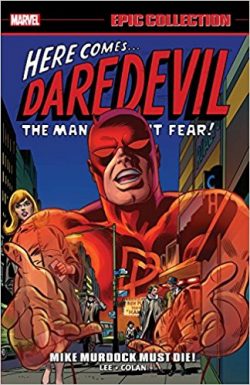
By Stan Lee, Gene Colan & various (Marvel)
ISBN: 978-1-3029-1004-4
Matt Murdock is a blind lawyer whose remaining senses hyper-compensate, making him an astonishing acrobat, formidable fighter and living lie-detector. Very much a second-string hero for most of his early years, Daredevil was nonetheless a striking and popular one, due in large part to the roster of brilliant artists who had illustrated the strip. He only really came into his own, however, after artist Gene Colan signed up for the long haul…
The natal DD battled thugs, gangsters, mad scientists, robots and a plethora of super-villains (and – as seen in this collection – even the occasional monster or alien invasion), quipping and wise-cracking his way through life and life-threatening combat.
Covering November 1966 – June 1968 and re-presenting Daredevil #21-41, crossover issue Fantastic Four #73, Daredevil Annual #1 – plus a bonus comedy caper from Not Brand Echh #4 – this second compilation (in both trade paperback and eBook formats) sees a marked improvement in overall story quality as scripter Stan Lee begins utilising longer soap operatic plot-threads to string together the unique fight scenes of Colan, who gradually shook off the remnants of his predecessor’s art style.
In a very short time John Romita had made the Sightless Swashbuckler his own before graduating to Spider-Man, so when Colan took over on DD, he initially kept the clipped, solid, nigh-chunky lines for rendering the Man Without Fear, but increasingly drew everything else in his loose, fluid, near-tonal manner. With these tales, his warring styles coalesced and the result was literally poetry in non-stop motion…
Without preamble the action opens with ‘The Tri-Man Lives’ (Lee, Colan, Frank Giacoia & Dick Ayers), containing Gangland themes and malignant machinations whilst sharing focus with super-menaces The Gladiator and Masked Marauder, whose eponymous killer android proves less of a threat than expected…
The villains had sought control of international organised crime syndicate the Maggia but their master plan to murder the Man Without Fear to prove their worthiness to lead goes badly awry after the kidnapped hero refuses to simply lie down and die…
Concluding in #23 with ‘DD Goes Wild!’ the ending sees our hero trapped in Europe, but soon making his way to England and a violent reunion with Tarzan analogue Ka-Zar who has become prime suspect in #24’s chilling puzzle ‘The Mystery of the Midnight Stalker!’
This tale contains my vote for the Most Obnoxious Misrepresentation of Britain in Comicbooks Award as a policeman – sorry, “Bobby†– warns, “STAY BACK, PLEASE! THE MILITIA WILL BE ARRIVING IN JIG TIME!â€
After clearing the jungle hero’s name, Matt Murdock heads back to America in time to enjoy the less-than-stellar debut of a certified second-rate super-villain as ‘Enter: The Leap-Frog!’ introduces a thief dressed like a frog with springs on his flippered feet (yes, really…).
However, the big event of the issue is meeting Matt’s hip and groovy twin brother Mike…
By the time ‘Stilt-Man Strikes Again’ (DD #26, March 1967) Colan was totally in command of his vision and a leaner, moodier hero was emerging. The major push of the next few issues was to turn the hopeless romantic triangle of Matt, best friend and Law-firm partner Foggy Nelson and their secretary Karen Page into a whacky quadrangle by introducing fictitious twin Mike Murdock, who would be “exposed†as Daredevil to divert suspicion from the blind attorney who actually battled all those weird villains…
Confused, much…?
Still skulking in the background, arch-villain Masked Marauder was slowly closing in on DD’s alter ego. He gets a lot closer in ‘Mike Murdock Must Die!’ (with Giacoia inks) after Stilt-Man teams with the Marauder and the ever-fractious Spider-Man once again clashes with old frenemy Daredevil before the villains meet their apparent ends.
The Sightless Swashbuckler “enjoys†his first encounter with extraterrestrials in #28’s moody one-trick-pony ‘Thou Shalt Not Covet Thy Neighbor’s Planet!’ – an Ayers-inked thriller wherein invading aliens’ blindness-inducing rays prove inexplicably ineffective against the Crimson Crime-crusher.
John Tartaglione inked the next tale, a solid, action-packed gangster-thriller entitled ‘Unmasked!’ whilst issue #30 opened a protracted and impressive clash with former Thor foes the Cobra and Mister Hyde. The bombastic first bout comes complete with an Asgardian cameo in ‘…If There Should Be a Thunder God!’
Attempting to catch the rampant super-criminals, DD masquerades as the Asgardian Avenger only to encounter the real McCoy. Sadly, the mortal hero is ambushed by the villains once the Thunderer departs and, as a result of the battle that follows loses his compensating hyper-senses. Thus, he must perpetrate a ‘Blind Man’s Bluff!’ which almost fools Cobra and Hyde…
Naturally, it all goes wrong before it all comes right and against all odds Murdock regains his abilities just in time ‘…To Fight the Impossible Fight!’…
Ramping up the devilish derring-do is the first Daredevil Annual: a visually impressive if rather lacklustre rogues’ gallery riot from Lee, Colan & Tartaglione, detailing five old foes ganging up on Daredevil as ‘Electro and the Emissaries of Evil!’
The Scarlet Swashbuckler quickly puts a pretty definitive smack-down on the electric evildoer and his acrimonious allies the Matador, Gladiator, Stilt-Man and Leapfrog…
Of more interest are the ‘Inside Daredevil’ pages, explaining his powers, providing the ‘Blueprint for an All-Purpose Billy Club’ and recapping the Matt/Mike Murdock “Faked News†situation, plus offering stunning pin-ups of Karen, Foggy, Ka-Zar, DD and a host of old foes such as Gladiator, Leap Frog, The Owl and Masked Marauder.
Rounding out the experience is comedy short ‘At the Stroke of Midnight!: An Actual Unrehearsed Story Conference with (and by) Stan and Gene!’
In the monthly comicbook, ‘Behold the Beetle’ sees the entire cast – Foggy, Karen and Murdock in the guise of his own (fictitious) twin brother – heading to Canada for World’s Fair Expo ’67 and encountering another borrowed costumed crazy in search of easy glory and untold riches…
With Daredevil crushed and captive, the prospects look bleak north of the border, but Hornhead soon outsmarts and outfights his techno-savvy foe in stunning sequel ‘To Squash the Beetle!’
Once safely returned to the Big Apple, DD’s undeserved reputation as a mere costumed acrobat induces another fearsome felon to attack in ‘Daredevil Dies First!’ The sightless wonder is targeted by old Fantastic Four foe The Trapster, who considers his quarry a mere stepping-stone in an overly-complex plan to destroy the World’s premier super-team.
Murdock manages to turn the tables in #36’s ‘The Name of the Game is Mayhem!’ (inked by Giacoia): a clash that leaves the blind hero triumphant but weakened: easy prey for another FF arch-foe. Tartaglione was back to ink the startling ‘Don’t Look Now, But It’s… Doctor Doom!’…
Helpless before the Iron Dictator, DD is trapped in ‘The Living Prison!’ (Giacoia inks) as Doom swaps bodies with the sightless crusader to facilitate his own sneak attack on the FF: a devilish ploy culminating in a stupendous Lee, Jack Kirby & Joe Sinnott crafted clash in Fantastic Four #73. The crossover conclusion sees the Human Torch, Thing and Mr. Fantastic battling Daredevil, Thor and Spider-Man in ‘The Flames of Battle…’
As always when involved in mind-swap cases, it’s perhaps most prudent to advise your friends when you defeat the bad guy and regain your original body…
The Man Without Fear finally found some of his own bad guys to bash in Daredevil #39 when old enemies the Ani-Men resurface with a new name and a different boss. Inked by George Tuska ‘The Exterminator and the Super-Powered Unholy Three’ reintroduces Bird-Man, Ape-Man and Cat-Man, now in the pay of a criminal genius working with time-based weapons, but the real meat of the tale is Foggy Nelson’s campaign to become New York City District Attorney.
That potential glittering prize is threatened, however, after the portly advocate unexpectedly revives his romantic relationship with ex-convict Deborah Harris, but at least now Matt Murdock’s only rival for Karen’s affections is “twin brother†Mike…
That story continued in #40 with DD banished to a timeless other-realm prison before leading to a spectacular cliffhanger in ‘The Fallen Hero!’ (inked by Tartaglione) before ending the only way it could with ‘The Death of Mike Murdock!’ as Matt takes advantage of his final catastrophic battle with the Exterminator to end the clumsy secret identity charade.
He still doesn’t come clean though, preferring to keep Daredevil’s secrets and let his friends grieve needlessly…
To Be Continued…
Rounding out the thrills and chills is a slice of exuberant slapstick schtick from Not Brand Echh #4 (November 1967) wherein Lee, Colan & Tartaglione again lampoon the romantic rollercoaster of Hoggy Nelson, Splat Murdock and secretary Miss Rage. Unable to win the comely lass Murdock decides on suicide by crook and as Scaredevil (the Man Who’s Scared of Fear) sets out to get ‘Defeated by the Evil Electrico!’
Other extras include original art pages and covers by Colan and the unused (presumed lost forever) original cover to DD #35, plus a Richard Isanove paint-augmented Colan cover originally seen as Daredevil Masterworks cover volume 3.
Despite a few bumpy spots, during this period The Man Without Fear blossomed into a truly magnificent example of Marvel’s compelling formula for success: smart stories, human characters and magnificent illustration. These bombastic tales are pure Fights ‘n’ Tights magic no fan of stunning super-heroics can afford to ignore.
© 1966, 1967, 1968, 2018 Marvel Characters, Inc. All rights reserved.

